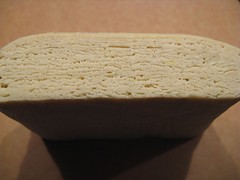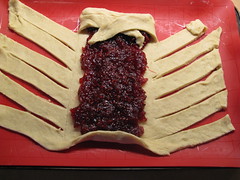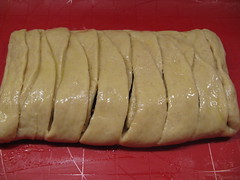
It is a bit of a time commitment making the dough since it has to chill for 30 minutes in between rolling it out & folding it. So, I picked an afternoon Matt was out of town & just focused on dough.
DANISH DOUGH
from Sherry Yard's The Secrets of Baking
Makes 2-1/2 pounds dough
Ingredients
For the dough (Detrempe)
1 ounce fresh yeast or 1 tablespoon active dry yeast
1/2 cup whole milk
1/3 cup sugar
Zest of 1 orange, finely grated
3/4 teaspoon ground cardamom
1-1/2 teaspoons vanilla extract
1/2 vanilla bean, split and scraped
2 large eggs, chilled
1/4 cup fresh orange juice
3-1/4 cups all-purpose flour
1 teaspoon salt
For the butter block (Beurrage)
1/2 pound (2 sticks) cold unsalted butter
1/4 cup all-purpose flour
DOUGH
Combine yeast and milk in the bowl of a mixer fitted with the paddle attachment and mix on low speed. Slowly add sugar, orange zest, cardamom, vanilla extract, vanilla seeds, eggs, and orange juice. Mix well. Change to the dough hook and add the salt with the flour, 1 cup at a time, increasing speed to medium as the flour is incorporated. Knead the dough for about 5 minutes, or until smooth. You may need to add a little more flour if it is sticky. Transfer dough to a lightly floured baking sheet and cover with plastic wrap. Refrigerate for 30 minutes.
Without a standing mixer: Combine yeast and milk in a bowl with a hand mixer on low speed or a whisk. Add sugar, orange zest, cardamom, vanilla extract, vanilla seeds, eggs, and orange juice and mix well. Sift flour and salt on your working surface and make a fountain. Make sure that the “walls” of your fountain are thick and even. Pour the liquid in the middle of the fountain. With your fingertips, mix the liquid and the flour starting from the middle of the fountain, slowly working towards the edges. When the ingredients have been incorporated start kneading the dough with the heel of your hands until it becomes smooth and easy to work with, around 5 to 7 minutes. You might need to add more flour if the dough is sticky.
BUTTER BLOCK
1. Combine butter and flour in the bowl of a mixer fitted with a paddle attachment and beat on medium speed for 1 minute. Scrape down the sides of the bowl and the paddle and then beat for 1 minute more, or until smooth and lump free. Set aside at room temperature.
2. After the detrempe has chilled 30 minutes, turn it out onto a lightly floured surface. Roll the dough into a rectangle approximately 18 x 13 inches and ¼ inch thick. The dough may be sticky, so keep dusting it lightly with flour. Spread the butter evenly over the center and right thirds of the dough. Fold the left edge of the detrempe to the right, covering half of the butter. Fold the right third of the rectangle over the center third. The first turn has now been completed. Mark the dough by poking it with your finger to keep track of your turns, or use a sticky and keep a tally. Place the dough on a baking sheet, wrap it in plastic wrap, and refrigerate for 30 minutes.
3. Place the dough lengthwise on a floured work surface. The open ends should be to your right and left. Roll the dough into another approximately 13 x 18 inch, ¼-inch-thick rectangle. Again, fold the left third of the rectangle over the center third and the right third over the center third. No additional butter will be added as it is already in the dough. The second turn has now been completed. Refrigerate the dough for 30 minutes.
4. Roll out, turn, and refrigerate the dough two more times, for a total of four single turns. Make sure you are keeping track of your turns. Refrigerate the dough after the final turn for at least 5 hours or overnight. The Danish dough is now ready to be used. If you will not be using the dough within 24 hours, freeze it. To do this, roll the dough out to about 1 inch in thickness, wrap tightly in plastic wrap, and freeze. Defrost the dough slowly in the refrigerator for easiest handling. Danish dough will keep in the freezer for up to 1 month.
I had a hard time rolling the dough out to the size it asked for & keeping it square. Plus the butter would ooze out or I'd get a hole in my dough. After the second turn I decided not to worry so much about the exact size & just try to get it 1/4-inch thick.
After the dough sat in the refrigerator for 5 hours, I cut it into 3 pieces & froze two to use later.

(look at those layers!)
For my filling I decided to use so fresh rhubarb I had just gotten in my CSA box. I mixed it with raspberries to make a jam.
RHUBARB/RASPBERRY JAM
2 c fresh rhubarb, cut into 1-inch pieces
1 c sugar
1/2 T lemon juice
1/2 c raspberries (I used frozen)
1/4 t ground cardamom
Mix the rhubarb, sugar & lemon together. Let sit, stirring occasionally, for a few hours up to overnight until juices form.
Bring the rhubarb mixture to a boil over med-high heat until the sugar dissolves. Then increase the heat & allow to boil until slightly thickened. Add the raspberries and continue to boil until thick. Remove from heat & stir in cardamom.
The jam can be stored for 1 week in the fridge.
This made enough to fill one braid made for 1/3 of the dough recipe.
DANISH BRAID
Makes enough for 2 large braids (since I had cut my dough in thirds I was making 10 inch braid at a time)
Ingredients
1 recipe Danish Dough (1/3 of the recipe in my case)
2 cups filling, jam, or preserves (I only needed a cup at the very most for my small braid)
For the egg wash: 1 large egg, plus 1 large egg yolk (I didn't bother with the second yolk)
1. Line a baking sheet with a silicone mat or parchment paper. On a lightly floured surface, roll the Danish Dough into a 15 x 20-inch rectangle (I rolled my smaller amount out to about 15 x 11) , ¼ inch thick. If the dough seems elastic and shrinks back when rolled, let it rest for a few minutes, then roll again. Place the dough on the baking sheet.
2. Along one long side of the pastry make parallel, 5-inch-long cuts with a knife or rolling pastry wheel, each about 1 inch apart. Repeat on the opposite side, making sure to line up the cuts with those you’ve already made.

3. Spoon the filling you’ve chosen to fill your braid down the center of the rectangle. Starting with the top and bottom “flaps”, fold the top flap down over the filling to cover. Next, fold the bottom “flap” up to cover filling. This helps keep the braid neat and helps to hold in the filling. Now begin folding the cut side strips of dough over the filling, alternating first left, then right, left, right, until finished. Trim any excess dough and tuck in the ends.
Egg Wash
Whisk together the whole egg and yolk in a bowl and with a pastry brush, lightly coat the braid.

Proofing and Baking
1. Spray cooking oil (Pam…) onto a piece of plastic wrap, and place over the braid. Proof at room temperature or, if possible, in a controlled 90 degree F environment for about 2 hours, or until doubled in volume and light to the touch.
2. Near the end of proofing, preheat oven to 400 degrees F. Position a rack in the center of the oven.
3. Bake for 10 minutes, then rotate the pan so that the side of the braid previously in the back of the oven is now in the front. Lower the oven temperature to 350 degrees F, and bake about 15-20 minutes more, or until golden brown. Cool and serve the braid either still warm from the oven or at room temperature. The cooled braid can be wrapped airtight and stored in the refrigerator for up to 2 days, or freeze for 1 month.
I let my first braid proof for about 2 - 2.5 hours at just over 70 F. It did rise some but after cooking I didn't think it was quite as flaky as it could be. I also found that after turning the braid & turning down the oven it only needed to cook for 10 more minutes or it started to burn.

Two weeks later a made a second braid with the dough in the freezer using ligonberry jam. This time I let it rise for just over 3 hours at almost 80 F. The extra time really made a difference & this braid came out much better, though I had a harder time getting the braid to stay closed at one.

My third braid I filled with cream cheese & apricot jam. It was about 80 F & I let it rise for 3 hours. This braid rose nicely & I think tasted the best with the addition of the cream cheese.
This challenge was a lot of fun & I learned a lot. Will I make Danish Braid again? Probably not unless its for a special brunch or such but its awful good to know I can make it.
Thanks Kelly & Ben for hosting this month! Check out the link for the Darling Bakers Blogroll on my sidebar to see lots of other versions of the Danish Braid.
I totally agree, this was a great month to start.I just love this challenge and I love that you made three very tasty braids!
ReplyDeleteHow fancy! You did a great job!
ReplyDeleteI'm a little bit on the other side of the fence: I can't wait to make this again!
ReplyDeleteYou should, too, seeing as how wonderful yours looks!
Welcome to DB.
looks so yummy!
ReplyDeletegreat job.
Again: amazing!
ReplyDeleteGreat job! Your fillings look great and the cream cheese apricot sounds delicious!
ReplyDeleteNice looking braid. I like the sound of the fresh rhubarb filling!
ReplyDeleteThey're beautiful! I adore raspberry, wish I'd thought of it!
ReplyDeleteBeautiful job, really deliciously done! :)
ReplyDeleteFor the first month, I think we did pretty darn great! I am sooo looking forward to the next challange!Thanks for stopping by my blog!
ReplyDeleteCongratulations on your first DB challenge! Your braid is beautiful.
ReplyDeleteSmart idea to make 3 smaller braids, lets you play around with more flavor combinations. I think I like the rhubarb and rasperry idea best, although the apricot- cream cheese is a close second. Way to go on your first DB challenge! Looks fantastic :)
ReplyDeleteWhat a lovely braid you have there! Great job on your challenge. It looks delish :)
ReplyDeleteI'm so glad you've become a DB! Great job on this challenge - all of them sound so delicious!
ReplyDeleteI am definitely going to have to make this again using a cream cheese and fruit filling! All of the braids I've seen with that combo have made me hungry! This was only my second challenge, so welcome to the DB's from a fellow newbie!
ReplyDeleteThis really was a great first challenge...and you succeeded! Great job!
ReplyDeleteWelcome to the Daring Bakers and congratulations on your first challenge! Your braids look awesome!
ReplyDeleteYour fillings look fabulous! Welcome to the DB's!
ReplyDeleteLovely layers! Your filling and braiding look fabulous. Well done.
ReplyDeleteWelcome to DB! You did so well on your 1st challenge. The rhubarb filling sound yummy, perfect for this braid. The picture about all the "layers" is amazing!
ReplyDeleteOH MY...your braid looks so good! I did freeze half of mine and after seeing yours, I just might bake it up tomorrow.
ReplyDelete